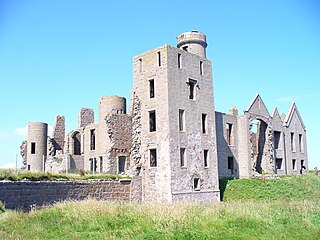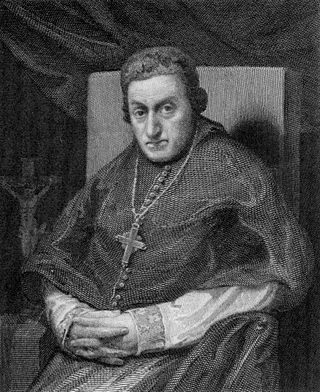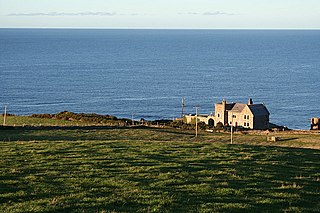Related Research Articles

Slains Castle, also known as New Slains Castle to distinguish it from the nearby Old Slains Castle, is a ruined castle in Aberdeenshire, Scotland. It overlooks the North Sea from its cliff-top site one kilometre east of Cruden Bay.
Andrew Scott was a Roman Catholic bishop who served as the Vicar Apostolic of the Western District of Scotland from 1832 to 1845.

The Scalan was a Scottish Catholic seminary and one of the few places in Scotland where the Catholic faith was kept alive during the anti-Catholic persecutions of the 18th century.

Auld Bourtreebush is a large Neolithic stone circle near Portlethen in Aberdeenshire, Scotland. It is also known as Old Bourtree Bush or Old Bourtreebush. This megalithic construction is situated near the Aquhorthies recumbent stone circle and the Causey Mounth, an ancient trackway which connects the Scottish Lowlands to the highlands. It is a scheduled monument.

Birse Castle is located in the Forest of Birse, Aberdeenshire, Scotland. Originally a square tower house, it was rebuilt in the first decade of the 20th century into an L-plan structure. The 1930 addition of a new wing gave it a Z-plan. The building was designated a category B listed building in 1971.

George Hay was a Scottish Catholic prelate and writer who served as Vicar Apostolic of the Lowland District from 1778 to 1805.

Dundarg Castle is a ruined castle about 2 kilometres (1.2 mi) north-northeast of New Aberdour, Aberdeenshire, Scotland, built within the ramparts of an earlier Iron Age promontory fort. It was described by W. Douglas Simpson as one of the nine castles of the Knuckle, referring to the rocky headland of North-East Aberdeenshire, and by Charles McKean as "Scotland's answer to Tintagel". It became a small Celtic monastery for a period.

Castle Forbes is a 19th-century country house in the Scottish baronial architecture style near Alford in Aberdeenshire, Scotland.
Aquhorthies may refer to:

Alexander Cameron was a Scottish Catholic prelate who served as the Vicar Apostolic of the Lowland District, Scotland.

St Mary's College, Blairs, situated near Aberdeen in Scotland, was from 1829 to 1986 a junior seminary for boys and young men studying for the Roman Catholic priesthood. Part of the former college now houses Blairs Museum, the museum of Scotland's Catholic heritage. The New Chapel is a Category A listed building, with the other buildings listed as Category B.

Balquhain Castle is a ruined tower house in Aberdeenshire, Scotland. It was the stronghold of the Leslies of Balquhain. The castle is located 4 kilometres (2.5 mi) west of Inverurie, and is protected as a scheduled monument.
Lismore Seminary was situated in Kilcheran House on the island of Lismore in the Inner Hebrides part of Argyll, Scotland. It served as a seminary for the Roman Catholic Church in Scotland in the 19th century. At the time it was the only seminary in the west of Scotland and for the Vicariate Apostolic of the Highland District. The house still stands and has a lime kiln from the time of the seminary within the grounds. Both the house and the kiln are category B listed sites.
Glass is a parish about 8 miles west of Huntly, Aberdeenshire, Scotland. It is now wholly located in Aberdeenshire but before the reorganisation of Scottish county boundaries in 1891 it was partly in Banffshire. The name Glass may have come from the Gaelic word for "grey," "meadow" or "stream."
Balbithan House is a three-storey L-plan keep dating from the 16th century. Alternative names are Old Place of Balbithan, Old Balbthan and Balbythan House. It is located in Aberdeenshire, Scotland, 4 kilometres (2.5 mi) south-east of Inverurie.

Westhall Castle, also known as Westhall House, is a country house located to the north of Oyne, in Aberdeenshire, Scotland. The house includes a 16th-century L-plan tower house, which was substantially extended in the 17th and 19th century. The house is a category A listed building.

John Geddes was a Scottish Catholic prelate who served as Coadjutor Vicar Apostolic of the Lowland District from 1779 to 1797. He was also rector of the Royal Scots College, Valladolid, from 1771 to 1780.

Barra Castle is an unusual L-plan tower house dating from the early 16th century, about two miles south of Oldmeldrum, above the Lochter Burn, in the parish of Bourtie, Aberdeenshire, Scotland. It occupies the site of the Battle of Inverurie (1308), in which Robert Bruce defeated John Comyn, Earl of Buchan.
Events from the year 1799 in Scotland.

The Church of The Incarnation was built between 1827 and 1829 as a Roman Catholic church, under the patronage of the Gordon family, in Banffshire, Scotland. It was originally built by John Gall, and finished between 1843 and 1844 by James Kyle with assistance from Walter Lovi. It was designated a Category B listed building in 1972, and upgraded to Category A in 1987. It ceased being used as an active church in 2012, and as of 2019 is on the Buildings at Risk Register for Scotland, described as being at moderate risk, and in poor condition.
References
- ↑ "House Of Aquahorthies | Canmore". canmore.org.uk. Retrieved 22 May 2024.
- ↑ British Listed Buildings retrieved 18 March 2013
- ↑ Story of Scalan from Scalan.co.uk, accessed 18 March 2013
- ↑ Aquhorthies House Archived July 14, 2014, at the Wayback Machine from The Seton Family, accessed 18 March 2013
- ↑ Bishop George Hay Archived July 14, 2014, at the Wayback Machine from The Seton Family, accessed 18 March 2013
- ↑ Archives Hub retrieved 18 March 2013